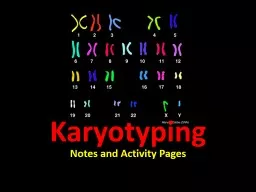

Chromosomal mutations Additional missing or damaged chromosomes cause several human genetic disorders One way of studying these disorders is to observe the chromosomes themselves Why do scientists study chromosomes ID: 780338
Download The PPT/PDF document "Karyotyping Notes and Activity Pages" is the property of its rightful owner. Permission is granted to download and print the materials on this web site for personal, non-commercial use only, and to display it on your personal computer provided you do not modify the materials and that you retain all copyright notices contained in the materials. By downloading content from our website, you accept the terms of this agreement.
Slide1
Karyotyping
Notes and Activity Pages
Slide2Chromosomal mutations
…Additional, missing, or damaged chromosomes cause several human genetic disorders.
One way of studying these disorders is to observe the chromosomes themselves.
Why do scientists study chromosomes?
Slide3Karyotypes are treated with chemicals that stops cell division at the metaphase stage.
During metaphase, the chromosomes are at the best/longest length for identification.
Slide4Karyotyping –
tool used to determine the sex of an individual or detect/identify
chromosomal abnormalities
.
Slide5Humans have 46 chromosomes in every diploid (2n) body cell. The chromosomes of a diploid cell occur in HOMOLOGOUS PAIRS
, which are pairs of chromosomes that are similar in size, shape, and the position of their centromere.
The cells are stained, and then placed on glass slides. The chromosomes are observed under the microscope and then photographed. There 2 chromosomes in each place on a
karyotypes
Slide6In humans, pairs 1-22
homologous
are called
AUTOSOMES
.
Autosomes transmit all genetic traits and conditions.
Each homologous and alike. (common)
Pair 23 determines the individual’s sex so that pair is referred to as the
SEX CHROMOSOMES
.
Slide7AND NOWWWWW…
We are going to view some Karyotypes and determine if there is a disorder and what kind of disorder (mutation)
Slide8Normal Female Karyotype
(XX at pair 23)
Station 1
Slide9Normal Male Karyotype
(XY at pair 23)
1b
Slide102
Down Syndrome
Slide11Down’s Syndrome
Female.
Trisomy 21, extra
chomosome
in pair 21.
Down syndrome is one of the most common chromosomal
disorders.Physical and mental development is slower.
Flat facial profile.
Broad forehead.
Thick tongue.
Upward
slant to the
eyes.Short arms and legs.
Slide123
Turner Syndrome
Slide13Turner
Syndrome
Females only.
Affects pair 23.
Results
from a missing or incomplete sex
chromosome.Turner syndrome can cause a variety of problems:
Short stature.Web neck.
Failure
to begin
puberty.
Infertility.
Heart defects.Learning disabilities.
Slide144
Patau
Syndrome
Slide15Patau
Syndrome
Female.
Trisomy 13; extra chromosome in pair 13.
Least
common and most severe of the
trisomies.
Survival is less than
3
days.
Heart defects.
Incomplete
brain development.Unusual facial features such as small or missing eyes, low set ears.Extra fingers and toes.Spinal defects.
Slide165
Klinefelter
Syndrome
Slide17Klinefelder
Syndrome
Males only.
Affects pair 23.
XXY syndrome.
Affects
the male hormonal development due to an extra X chromosome.
Lack of testosterone can cause less facial and body hair, breast enlargement, and infertility.
Taller
than the average
male; longer arms.
Skinny
with wider hips and less muscular structure.
Slide186
Edwards Syndrome
Slide19Edward’s
Syndrome
Female.
Trisomy 18; extra chromosome in pair 18.
M
ore
than 130 individual defects of the craniofacial structures, brain, heart, kidneys, and gut.Small mouth, jaw, and short neck.
Back of skull is prominent.Malformed ears.
Clenched fists with overlapping fingers; flexed legs and feet.
Slide207
Triple-X Syndrome
Slide21Triple-X
Syndrome
Female.
Trisomy X; extra X chromosome at pair 23.
Taller than average.
No unusual physical features.
Increased
risk of learning disabilities and delayed development of speech and language
skills.
Weak
muscle
tone.
Behavioral and emotional difficulties.
Slide228
XYY Syndrome
Slide23XYY
Syndrome
Males only.
Affects pair 23
.
Extra
copy of the Y chromosome.Taller
than average.Increased
risk of learning
disabilities.
Prone to severe acne.
May
include antisocial or behavioral problems.